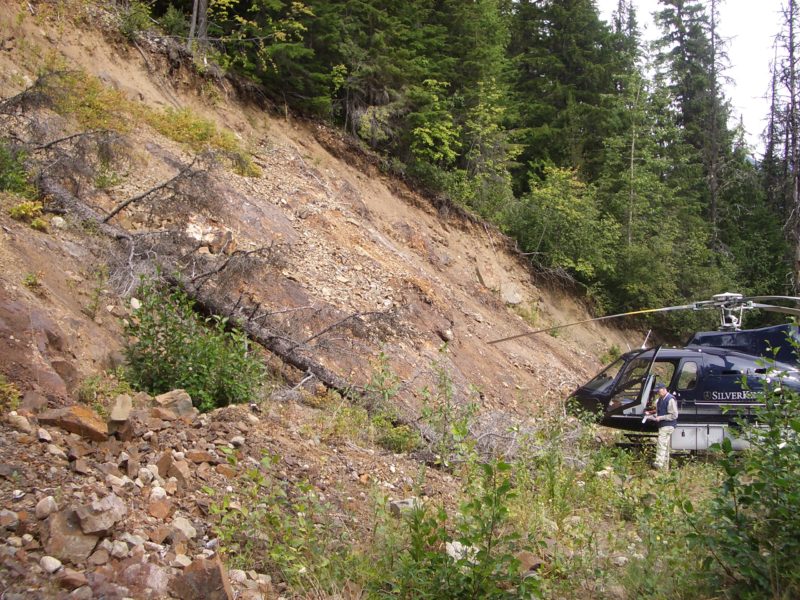Jaxon Mining samples up to 3,052 g/t AgEq at Netalzul Mt, British Columbia

Jaxon Mining Inc. [JAX-TSXV; JXMNF-OTC; 0U31-FSE] reports extending the soil and rock sampling program at the Netalzul Mt project where 120 rock and 409 soil samples were collected from the new areas in the 2021 field season. Netalzul Mt is one of seven porphyry system targets on Jaxon’s 100%-owned Hazelton property in northwestern British Columbia, approximately 50 km north of Smithers.
The samples report up to 3,052 g/t silver equivalent, including 2,915 g/t silver, 0.39 g/t gold, 0.35% copper, 2.06% lead and 0.43% antimony. Based on Mineral Deposits Research Unit’s Toodoggone report, the samples identify a high MPIx (MDRU Porphyry Index) centre area coincident with the target vectors generated by Fathom Geophysics’ previous modelling. These surface expressions are a product of the large epithermal porphyry system Jaxon is targeting within Netazul Mt.
Thirty-eight of the new rock samples were assayed for porphyry geochemical index elements and the results outline a high MPIx centre which is used to vector in on the location of the centre of the porphyry system.
Highlights of 2021 rock and soil sampling at Netalzul Mt project include 409 soil samples were collected and tested in the field with a handheld XRF analyzer. A large strong Zn anomaly (up to 3681 ppm; 11.7% of soil samples greater than 1000 ppm) was identified in the strongly faulted hornfels area to the north boundary of the Netalzul granodiorite intrusion. The Zn anomaly overlays the Rocks 1 geochemical anomaly previously defined by Fathom Geophysics in early 2021 (news release), and coincides with a discrete demagnetized zone, comparable to the Blackwater deposit in the same geological setting 250 km southeast of the Netalzul Mt project;
A total of 38 of the 2021 rock samples were assayed for 48 elements to extend the geochemical survey area; 82 mineralized rock samples were collected and assayed for 34 elements. Two new artisanal mining adits (Adit 3 and Adit 4) were discovered in the east extension of the Daisy South Adit Zone. Silver grades can be up to 2915 g/t with 0.39 g/t gold, 0.35% copper, 2.06% lead and 0.43% antimony from a one-metre chip outcrop sample (sample ID#72013) at the Adit 4 area within the Daisy South Adit Zone; gold grades can be up to 7.01 g/t with 49 g/t silver and 0.53% copper from a one-metre quartz vein zone chip outcrop sample (sample ID #A0027300) at Daisy North Contact Zone; copper grades can be up to 1.47% with 20 g/t silver from a porphyry monzonite dyke outcrop grab sample (sample ID #72521) at the southwest area of Netalzul Mt project. These rock samples have typical epithermal intermediate sulfidation (IS) mineralization or display the disseminated porphyry characteristics generated by deep porphyry systems as prototypically modeled.
John King Burns, Chairman and CEO, said, “Netalzul Mt exhibits one of the strongest geochemical anomalies indicating the location of a porphyry system in BC to date and was ranked as Jaxon’s priority porphyry target, the first of seven on the Hazelton property, using Fathom Geophysics’ comparative porphyry model earlier in 2021.
“Jaxon’s primary technical focus in the winter of 2022 is to reprocess all existing geochemical and geophysical datasets, integrate the new data collected in 2021 and regenerate our geological models to show the geometry of and generate more precise locational coordinates for the Netalzul Mt porphyry system. The modelling will be reviewed by Jaxon’s geochemical, geophysical and structural advisors as part of a comprehensive drill target vectoring exercise. In the spring of 2022, we expect to publish the updated 3D geological model illustrating projections of the Netalzul Mt porphyry system and the specific vectors that each of the ~5 planned, ~1200-metre tests holes will follow.”
Jaxon has seven porphyry system targets on its Hazelton property, an interconnected network of concessions spanning 705.7 km2 in the Toodoggone region of the Skeena Arch, northwest British Columbia. Red Springs is the second target being prepared for drilling. The five other targets are in various stages of exploration.
